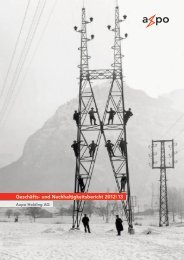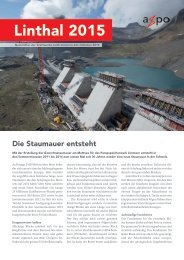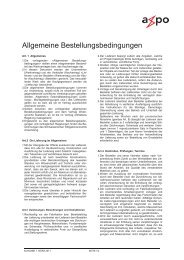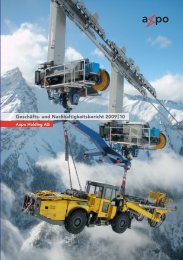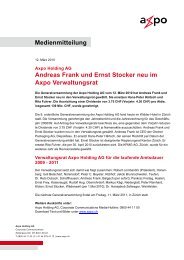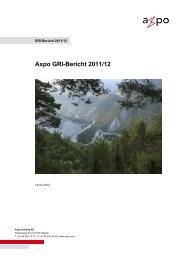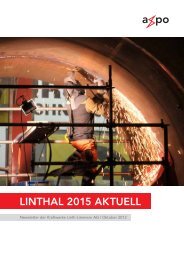Annual report 2008/09 - Axpo Group
Annual report 2008/09 - Axpo Group
Annual report 2008/09 - Axpo Group
You also want an ePaper? Increase the reach of your titles
YUMPU automatically turns print PDFs into web optimized ePapers that Google loves.
<strong>Axpo</strong> believes in the potential of electric mobility. In future,<br />
electric and hybrid vehicles will be an integral part of the<br />
Swiss streetscape and a dense public transport network will<br />
link town and country. As a result, the importance of electricity<br />
as an energy carrier will increase substantially, and electricity<br />
will be the “fuel” of the future.<br />
The race is on to produce the fi rst electric car<br />
for mass production<br />
Small, innovative car manufacturers still have the edge, such as the<br />
Californian company Tesla Motors with their sporty Roadster or the<br />
Norwegian manufacturer Think, which started developing its Think<br />
City electric car 18 years ago. With fuel-saving cars now becoming<br />
a roaring success in the US as well as Europe, they would like to keep<br />
the market to themselves for a few more years.<br />
This, however, is not likely to happen: the major car manufacturers<br />
may have been dragging their feet for a long time, but now they<br />
are all the more determined to catch up. Backed by large R & D budgets,<br />
they are focusing on alternative engines for the cars of the future.<br />
At the IAA International Motor Show in Frankfurt in September 20<strong>09</strong>,<br />
several car manufacturers exhibited electric cars that are more<br />
or less ready to go into production. The Chevrolet Volt, the Mitsubishi<br />
i-MiEV and the Nissan Leaf will be available on the market sometime<br />
in 2010.<br />
Illustration: Think<br />
Illustration: Tesla<br />
Californian car manufacturer<br />
Tesla Motors demonstrates<br />
with its Roadster<br />
that electric cars<br />
can look really sporty.<br />
Already available: Think<br />
City, the electric car from<br />
Norway, has a range of<br />
180 kilometres and<br />
achieves a top speed of<br />
100km/h.h.<br />
Electric cars use energy far more effi ciently<br />
than vehicles with internal combustion<br />
engines. Although an electric car<br />
uses around 15 kWh of electricity to<br />
travel 100 kilometres, the decisive factor<br />
is the way in which this electricity has<br />
been generated. The Swiss electricity mix,<br />
more or less CO2-free, means that an<br />
electric car releases far less CO2 than even<br />
a fuel-effi cient internal combustion engine.<br />
CO2 emissions in transport can be<br />
reduced signifi cantly with electric cars<br />
and our low-CO2 electricity mix.<br />
The battery is what matters<br />
<strong>Axpo</strong> is proceeding on the assumption<br />
that electric mobility will gain a larg -<br />
er market share in the longer term. At<br />
present there are approximately 500<br />
electric passenger cars with marginal<br />
electricity consumption on the road<br />
in Switzerland. If just 20 % of all vehicles<br />
in Switzerland were electric, only<br />
around 1.6 terawatt hours of electricity<br />
would be needed (total current electricity<br />
consumption for Switzerland:<br />
58 terawatt hours). As electric mobility<br />
is likely to develop slowly, electricity<br />
consumption will also grow slowly and<br />
not in a single leap.<br />
But it is energy storage that is<br />
causing developers the biggest headaches<br />
– the battery systems in use at present<br />
are hugely expensive and heavy, and they<br />
limit the distance that a car can travel.<br />
Researchers around the globe are working<br />
feverishly to develop the battery of the<br />
future. The lithium-air battery is a beacon<br />
of hope – fi rst prototypes exceed the<br />
energy density of the present-day lithiumion<br />
battery eightfold. Another advantage<br />
lies in the fact that this technology<br />
uses atmospheric air, thereby saving<br />
weight. However, there are still many<br />
obstacles to surmount before such<br />
systems are ready for the market.





